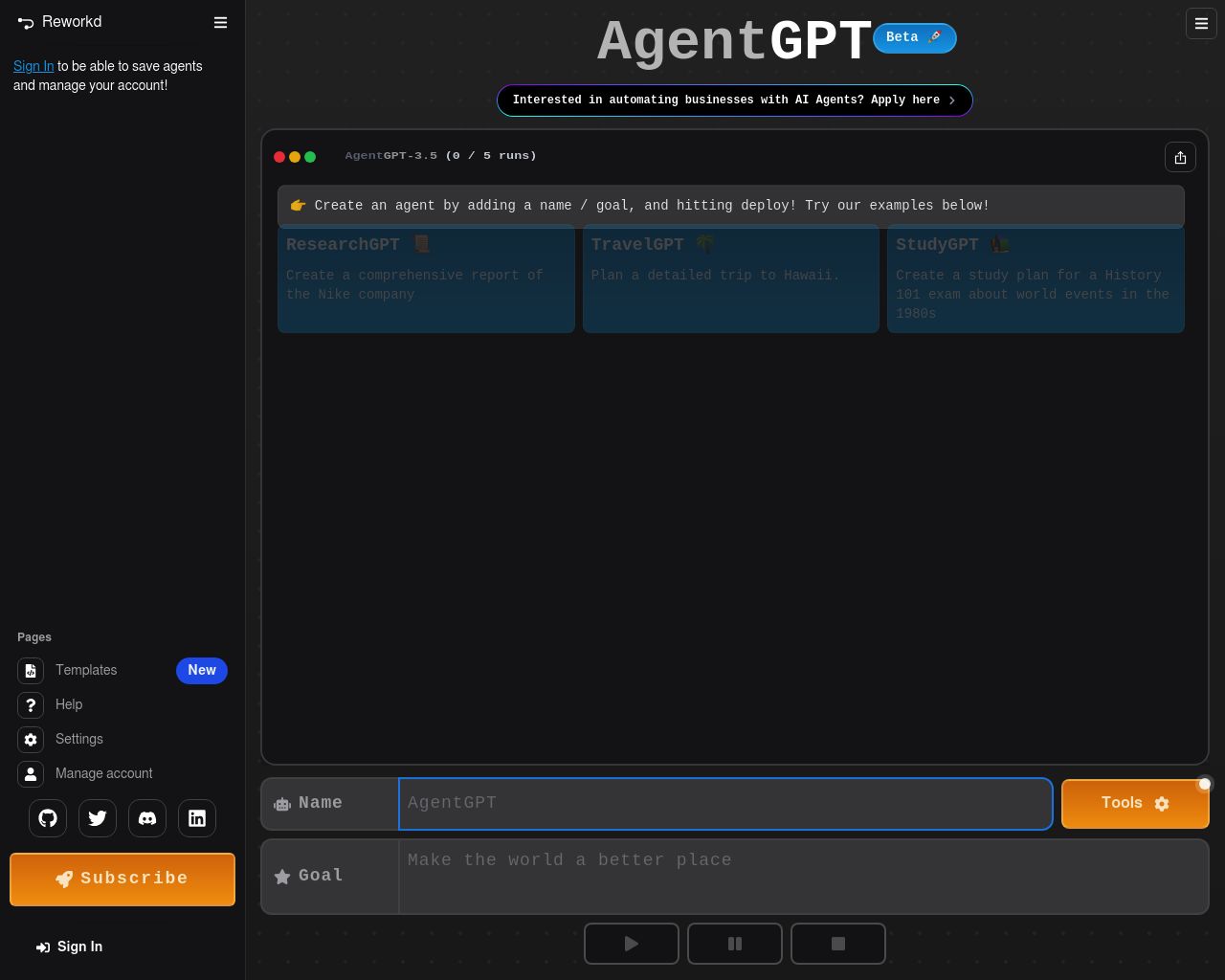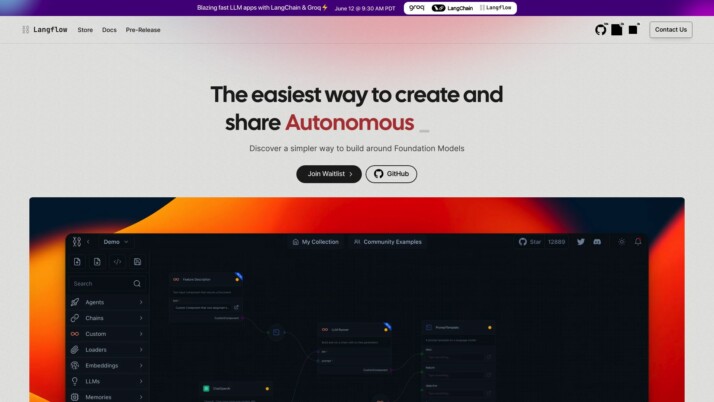AgentGPT vs. Langflow: Comparing AI Agent Development Platforms
AI agent development platforms are transforming how businesses and developers harness artificial intelligence. AgentGPT vs. Langflow stand out as powerful options, each offering unique approaches to creating AI-powered solutions. AgentGPT excels in autonomous agent functionality with advanced memory management, while Langflow provides an intuitive visual interface for building AI workflows.
This comparison explores their core features, strengths, and limitations to help you choose the right tool for your AI development needs. We’ll also introduce SmythOS, a comprehensive platform that combines the best of both worlds and takes AI agent development to new heights with unmatched flexibility, scalability, and integration capabilities.
AgentGPT Overview
AgentGPT empowers developers to create and deploy autonomous AI agents in a web environment. Unlike traditional chatbots, these agents tackle broad, goal-oriented tasks with impressive efficiency. The platform’s web-based interface sets it apart from locally-run alternatives, offering a seamless experience for users across various technical backgrounds.
AgentGPT empowers developers to create and deploy autonomous AI agents in a web environment. Unlike traditional chatbots, these agents tackle broad, goal-oriented tasks with impressive efficiency.


AgentGPT boasts a robust feature set tailored for both individual developers and enterprise teams. User authentication, agent run saving and sharing, and dynamic translations enhance collaboration and accessibility. The platform’s AI model customization options and web browsing capabilities expand the potential applications, from simple task automation to complex data analysis.
A standout feature of AgentGPT is its innovative use of vector databases for memory management. This technology allows AI agents to maintain context over extended interactions and access long-term memory, significantly enhancing their problem-solving capabilities. The platform’s scalability shines through its cloud offering, which integrates seamlessly with popular tools like LangChain.
A standout feature of AgentGPT is its innovative use of vector databases for memory management. This technology allows AI agents to maintain context over extended interactions…
While AgentGPT offers impressive capabilities, it’s worth noting that some advanced features like multimodal interactions and a visual builder are not currently available. Additionally, the platform’s focus on web-based deployment may limit options for users seeking more varied deployment methods. Despite these considerations, AgentGPT’s commitment to continuous improvement and community-driven development suggests a bright future for the platform.
Langflow Overview
Langflow empowers users to create AI applications without extensive coding knowledge. This open-source platform simplifies the process of building complex AI workflows through its intuitive drag-and-drop interface.
Langflow’s visual builder allows users to construct AI workflows by connecting pre-built LangChain components. These components include large language models, agents, and other AI tools, enabling the creation of sophisticated AI applications. The platform’s user-friendly approach makes it accessible to developers, researchers, and business professionals seeking to leverage AI technology.
Langflow empowers users to create AI applications without extensive coding knowledge. This open-source platform simplifies the process of building complex AI workflows through its intuitive drag-and-drop interface.


Key features of Langflow include its powerful Command-Line Interface (CLI) for advanced users, secure authentication mechanisms, and API integration capabilities. The platform also supports the creation of custom components using Python scripts, allowing for tailored functionality within the Langflow ecosystem.
While Langflow excels in accessibility and customization, it may present a learning curve for users entirely new to AI workflows. The platform’s low-code approach, while powerful, might not offer the same level of control as high-code solutions for highly specific needs. Additionally, concerns about scalability for large-scale deployments and very complex workflows may arise.
Langflow’s vision centers on democratizing AI by making it easier for individuals to build and integrate AI applications into their workflows. By providing a low-code platform with extensive customization options and secure authentication, Langflow aims to empower users to leverage AI technologies effectively, regardless of their technical background.
Feature Comparison
AgentGPT and Langflow offer distinct approaches to AI agent development, with notable differences in their core components and security features. AgentGPT excels in autonomous agent functionality and memory management, utilizing vector databases for enhanced context retention. This allows AgentGPT’s agents to maintain execution history and access long-term memory, significantly boosting their problem-solving capabilities over extended interactions.
Langflow, on the other hand, provides a more accessible entry point for AI application development through its intuitive drag-and-drop interface. While it lacks AgentGPT’s sophisticated memory management, Langflow compensates with a robust visual builder that simplifies the creation of AI workflows. This feature makes Langflow particularly appealing to users with limited coding experience, allowing them to construct complex AI applications using pre-built LangChain components.
In terms of security, both platforms offer OAuth authentication, but AgentGPT’s implementation appears more comprehensive, supporting multiple providers like Google, GitHub, and Discord. Langflow’s security features, while present, are not as extensively detailed in the available information. This gap in security specifications could be a concern for users dealing with sensitive data or requiring robust access controls.
Feature Comparison Table
| AgentGPT | Langflow | SmythOS | |
|---|---|---|---|
| CORE FEATURES | |||
| Visual Builder | ❌ | ✅ | ✅ |
| No-Code Options | ❌ | ✅ | ✅ |
| Explainability & Transparency | ❌ | ✅ | ✅ |
| Problem-Solving Capabilities | ✅ | ❌ | ✅ |
| Human-AI Interaction | ❌ | ✅ | ✅ |
| Work as Team | ✅ | ❌ | ✅ |
| Bulk Work | ✅ | ❌ | ✅ |
| Agent Work Scheduler | ✅ | ❌ | ✅ |
| SECURITY | |||
| Constrained Alignment | ❌ | ✅ | ✅ |
| Data Encryption | ✅ | ❌ | ✅ |
| IP Control | ❌ | ❌ | ✅ |
| COMPONENTS | |||
| Foundation AIs | ❌ | ❌ | ✅ |
| All other APIs, RPA | ✅ | ❌ | ✅ |
| Data Lakes | ❌ | ✅ | ✅ |
| DEPLOYMENT OPTIONS (EMBODIMENTS) | |||
| Deploy as API | ✅ | ❌ | ✅ |
| Staging Domains | ❌ | ✅ | ✅ |
| Production Domains | ❌ | ❌ | ✅ |
| API Authentication (OAuth + Key) | ✅ | ❌ | ✅ |
| Deploy as Site Chat | ✅ | ❌ | ✅ |
| Deploy as Scheduled Agent | ❌ | ✅ | ✅ |
| Deploy as GPT | ✅ | ❌ | ✅ |
| DATA LAKE SUPPORT | |||
| Sitemap Crawler | ❌ | ❌ | ✅ |
| YouTube Transcript Crawler | ❌ | ❌ | ✅ |
| URL Crawler | ✅ | ❌ | ✅ |
| PDF Support | ✅ | ❌ | ✅ |
Best Alternative to AgentGPT and Langflow
SmythOS emerges as the superior alternative to AgentGPT and Langflow, offering a comprehensive platform for AI agent development and deployment. We combine the best of both worlds: the autonomous functionality of AgentGPT and the user-friendly interface of Langflow, while surpassing both in features and capabilities.
Our visual builder simplifies the creation of complex AI workflows, allowing users of all skill levels to design sophisticated agents without writing code. This approach democratizes AI development, making it accessible to a broader audience while still providing the depth and flexibility required by experienced developers.
SmythOS excels in its extensive feature set, offering capabilities that neither AgentGPT nor Langflow can match.
SmythOS excels in its extensive feature set, offering capabilities that neither AgentGPT nor Langflow can match. Our platform supports multi-agent collaboration, allowing teams of AI agents to work together on complex tasks. We also provide robust problem-solving capabilities, enabling agents to tackle intricate challenges across various domains. These features, combined with our human-AI interaction tools, create a powerful ecosystem for developing truly intelligent and responsive AI solutions.
Unlike our competitors, SmythOS offers unparalleled flexibility in deployment options. Users can deploy their agents as APIs, webhooks, scheduled tasks, or even integrate them into popular platforms like ChatGPT. This versatility ensures that AI solutions built with SmythOS can be seamlessly incorporated into existing workflows and systems, maximizing their utility and impact.
We pride ourselves on offering unlimited use cases, far surpassing the limitations of AgentGPT and Langflow. Whether you’re building a customer service chatbot, an automated data analysis system, or a complex decision-making tool, SmythOS provides the tools and infrastructure to bring your vision to life. Our platform scales effortlessly from simple prototypes to enterprise-grade solutions, ensuring that your AI agents can grow and adapt as your needs evolve.
Conclusion
AgentGPT and Langflow offer distinct approaches to AI agent development, each with unique strengths. AgentGPT excels in autonomous agent functionality and sophisticated memory management, while Langflow provides an accessible entry point through its intuitive visual builder. However, both platforms have limitations that may not fully meet the needs of all users.
SmythOS emerges as the superior choice, combining the best of both worlds and offering additional advanced features. Our platform’s drag-and-drop interface rivals Langflow’s ease of use, while our robust memory management and autonomous capabilities match or exceed those of AgentGPT. SmythOS takes AI agent development to the next level with its extensive integration ecosystem, supporting over 300,000 integrations and a wide range of AI models.
Unlike AgentGPT and Langflow, SmythOS offers unparalleled deployment flexibility. Our “Create Once, Deploy Anywhere” approach allows users to seamlessly integrate AI agents into multiple environments, from chatbots and APIs to scheduled tasks and GPT plugins. This versatility, combined with our platform’s scalability and enterprise-grade security features, makes SmythOS the ideal choice for businesses of all sizes looking to harness the full potential of AI.
Ready to experience the future of AI agent development? Explore our diverse range of AI-powered agent templates to jumpstart your projects, or create a free SmythOS account to start building your own custom AI agents today. With SmythOS, you’ll revolutionize your workflow and unlock unprecedented levels of automation and efficiency.
Last updated:
Disclaimer: The information presented in this article is for general informational purposes only and is provided as is. While we strive to keep the content up-to-date and accurate, we make no representations or warranties of any kind, express or implied, about the completeness, accuracy, reliability, suitability, or availability of the information contained in this article.
Any reliance you place on such information is strictly at your own risk. We reserve the right to make additions, deletions, or modifications to the contents of this article at any time without prior notice.
In no event will we be liable for any loss or damage including without limitation, indirect or consequential loss or damage, or any loss or damage whatsoever arising from loss of data, profits, or any other loss not specified herein arising out of, or in connection with, the use of this article.
Despite our best efforts, this article may contain oversights, errors, or omissions. If you notice any inaccuracies or have concerns about the content, please report them through our content feedback form. Your input helps us maintain the quality and reliability of our information.
